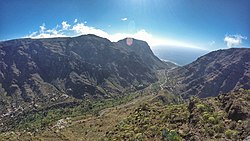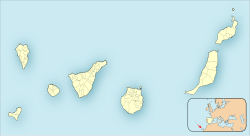Valle Gran Rey | |
|---|---|
 Valle Gran Rey | |
 Municipal location in La Gomera | |
| Coordinates: 28°6′N17°20′W / 28.100°N 17.333°W | |
| Country | |
| Autonomous Region | Canary Islands |
| Province | Santa Cruz de Tenerife |
| Island | La Gomera |
| Government | |
| • Mayor | Angel Piñero Cruz |
| Area | |
• Total | 32.36 km2 (12.49 sq mi) |
| Population (2018) [2] | |
• Total | 4,484 |
| • Density | 140/km2 (360/sq mi) |
| Time zone | UTC+0 (GMT) |
| Website | www.vallegranrey.es |


Valle Gran Rey is a municipality in the western part of the island La Gomera, in the province of Santa Cruz de Tenerife of the Canary Islands, Spain. The Guanche name of the area was Orone. [3] The seat of the municipality since 1930 is La Calera; previously it was in Arure.
Contents
- Geography and climate
- Subdivisions
- Historical population
- Notable natives and residents
- See also
- References
- External links
The population was 4,240 in 2013, [4] and the area is 32.36 square kilometres (12.49 sq mi). [1] Valle Gran Rey borders the municipality of Vallehermoso to the east, while the Atlantic Ocean lies to the west.


